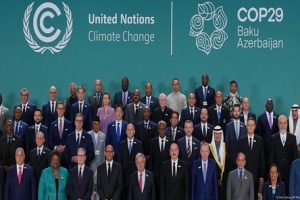
The Horn of Africa, including Ethiopia, has been experiencing recurring droughts, which have been connected to climate change. Climate change is altering rainfall patterns, resulting in longer and more extreme dry seasons in the region. This has had a disastrous effect on agriculture, food security, and water supply in the region.
The population is now experiencing food shortages and hunger as a result of crop failures, animal mortality, and water scarcity brought on by the droughts. In rural regions, where many people depend on subsistence farming for a living, the situation is especially bad.
The Ethiopian government, along with international organizations, has been implementing steps for adaptation and mitigation in response to the droughts and the wider difficulties brought about by climate change. Among these, strengthening early warning systems for extreme weather occurrences, encouraging sustainable agricultural methods, and water management are worth mentioning.
In addition, the government has put in place several initiatives and methods to deal with the problems impacted communities confront. As a result, it offers individuals impacted by the drought immediate relief aid. For people affected by drought, the government offers emergency relief assistance, such as food assistance, water supplies, and medical treatment. This lessens the immediate requirements and averts serious humanitarian emergencies. Additionally, early warning systems have been put in place by the government to keep an eye on meteorological trends, evaluate the likelihood of a drought, and promptly notify populations that are in danger. This enhances readiness and emergency response activities before a crisis occurs.
The country also implements drought resilience initiatives, which center on enhancing communities’ ability to deal with and adjust to drought situations. This includes encouraging methods for sustainable agriculture, conserving water, managing water shade, diversifying sources of income, and so on. In particular, the government has designed programs for mitigating and adapting to climate change, such as Yelemat Turufat and the Green Legacy Initiative. The nation has also made investments in climate-smart agriculture methods, forestry initiatives, and renewable energy. To increase resistance to drought and other climate-related difficulties, it has given priority to climate change adaptation efforts.
Though a lot has been done to address the effects of the drought, some individuals and groups have attempted to politicize the matter. They even make use of numbers that don’t match the available information. In response, the Ethiopian National Disaster Risk Management Commission denounced individuals who have been politicizing the country’s drought, noting that assessments by the government, other relevant parties, and international organizations have established that Ethiopia is experiencing a drought rather than a famine.
According to Disaster Risk Management Commission Commissioner Shiferaw Teklemariam, recurring drought affects not just Ethiopia but also parts of the region. As a result, it is unnecessary to politicize humanitarian aid and encourage all players to contribute to the country’s humanitarian response. He stressed that the federal government’s obligation is consistent with how we are organized, pointing out that the government has provided emergency humanitarian relief and coordinated solutions to the crisis.
He stated that “there are political and propaganda intentions that want to use the current humanitarian situation for something else.” If the drought worsens and becomes a famine, the government would halt all other activity, including all development projects, all meetings, and so on, to assist the victims.”
He further noted that each player at every level of the government system, including local governments, states, and the business sector, must have a role to play. Using the gross assessment, he stated that “the worst period will be during July-September, which is now equivalent to 10.8 million beneficiaries when we reach that season.” He then went on to mention early warning and early action results, village assessment survey, household economic analysis, displacement tracking metrics, and any rapid onset type of disasters concluded for the year. However, as of right now, the beneficiary counts for January, February, and March stand at 6.6.” The government, acting through the commission, is now allocating a substantial sum of money to assist the most vulnerable citizens.
In the previous five or six months, it might have reached as much as 200 million US dollars. Moreover, we are investing around 50 million USD for the next season, as I speak. About 3.5 million of the 6.6 beneficiaries, who are mostly from Northern Ethiopia, are receiving a sizeable contribution from the federal government to the regional states. This is the Amhara region, Afar, and Tigray.
He continued, saying that in addition to other areas of the nation, there are difficulties in the Somali and Oromia regions. “As a result, the federal response that we are undertaking must be complemented by the regional responses as well.” In addition to the federal government, municipalities, regional governments, and the business sector all need to play a significant role in combating the drought. He emphasizes that to help those in need, everyone must make a material contribution.
Ethiopian Prime Minister Abiy Ahmed, on his part, stated that the government of Ethiopia will continue to help drought-affected areas and save residents’ lives at any cost. The Prime Minister indicated that drought has happened in some sections of Tigray, Amhara, and Oromia, which is not unusual for Ethiopia. Using the drought as a political tool, however, is inappropriate because the drought was not caused by the government.
The premier emphasized that last year’s cooperation to help Borena residents afflicted by the drought was excellent and asked for further cooperation to preserve lives in drought-stricken areas. While collaboration is essential to preventing any drought-related deaths, it is harmful to use the drought as a political instrument.
According to the premier, “We will do our best to help our people to pass such a difficult time,” and the government would continue to support the people to the fullest extent of its capabilities. Claiming to refute the unfounded charge that his administration neglected the issue, he said that the government has set aside 15 billion Birr to assist drought victims.
He underlined the importance of improving output and productivity to deal with the recurring drought. As a result, the nation planted wheat over 300,000 hectares of land during the last Ethiopian harvest season from which over 120 million quintals of harvest are expected. This demonstrates that citizens should maintain government-initiated food security measures.
Generally, to address the root causes of the droughts and increase resilience to the effects of climate change in the future, however, much more work has to be done. To achieve this, coordinated national measures to lower greenhouse gas emissions, promote sustainable development, and improve community resilience to climate-related issues would be needed.
BY EPHREM ANDARGACHEW
THE ETHIOPIAN HERALD TUESDAY 13 FEBRUARY 2024





